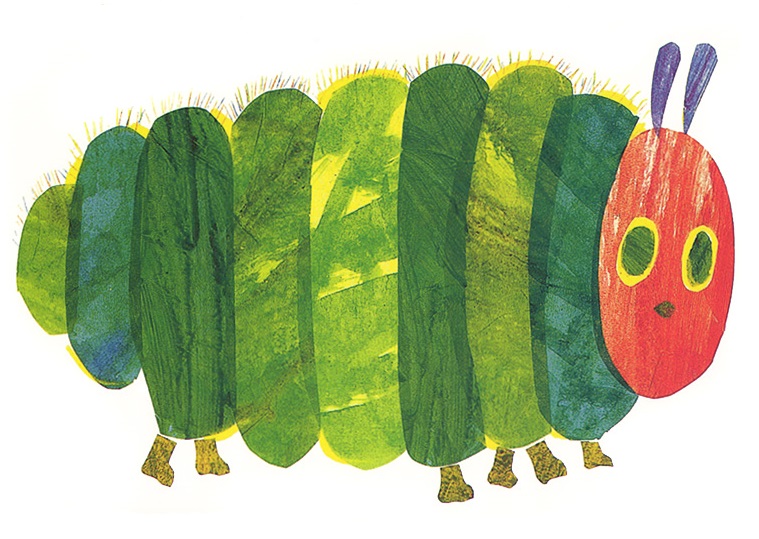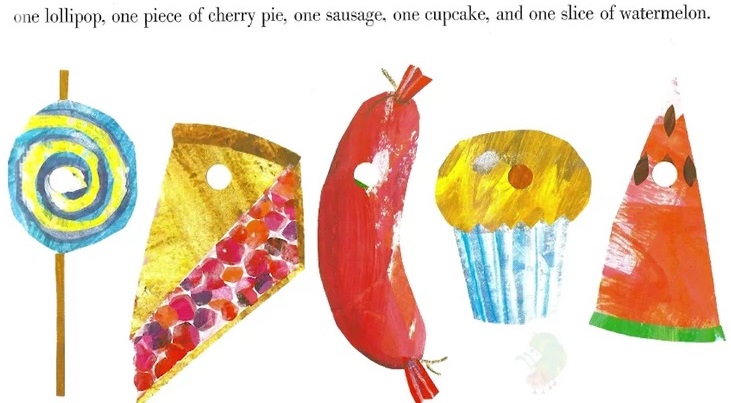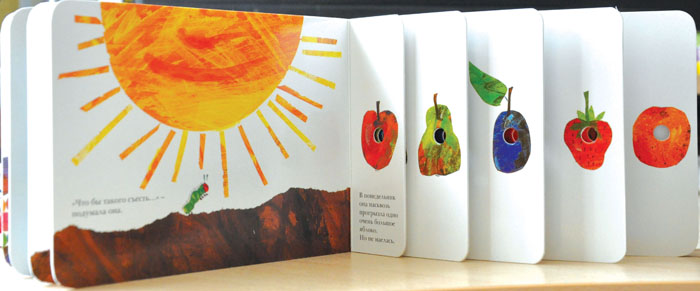
The Very Hungry Caterpillar Published by Penguin Random House. was written over forty years ago and translated into over fifty languages. Its popularity in the West is comparable to that of Harry Potter. Ever since it appeared on Russian bookshelves, it has instantly won the hearts of little ones and their parents. So what’s the secret to its immense success?
Fifty years ago one very hungry caterpillar gnawed through a children’s book, leaving little holes in its pages and granting its author, the artist Eric Carle, international fame.
No, it wasn’t quite like that. One day, lost in thought, an artist by the name of Eric Carle—by then already a well-known graphic designer—found himself holding a hole-puncher. He started punching holes in a sheet of paper that happened to be there. Those little holes, arranged in a row, called to mind the traces of life of a small creature, as though someone had gnawed through the paper here and there. Who could it be? A little worm? Eric Carle was by then already coming up with books, as an artist and a writer. Those who knew him jokingly called him “a picture writer.” He will confirm those words—he can never say what comes first, the image or the text. It works out differently each time. Yet the text in Eric Carle’s books is inseparable from the pictures and the book’s “engineering.” The ravenous little worm Carle envisions eventually evolves into a very hungry caterpillar. The holes take their places in an apple, some pears, several plums, oranges, and extraordinary foods like cakes and ice cream. The result is a thick board book with unusually built pages, on each of which anyone, child or adult, will easily identify the tracks left by the hungry caterpillar. You can follow it as it “crawls” from page to page getting bigger and bigger, fatter and fatter, until it becomes a satisfied, fat, enormous caterpillar. The caterpillar, finally full, spins itself a cocoon and on the last spread transforms into a wonderful, colorful butterfly.
In some countries—in Israel, for example—The Very Hungry Caterpillar is used to teach future educators how to introduce books to very small children. They have a whole method to discovering this book with little ones, finding new opportunities to comprehend the text and pictures. The Very Hungry Caterpillar first came out in Russia in 2008, published by “Pink Giraffe.” Despite parents’ reservations, it gained instant and immense popularity with progressive parents. Naturally, we want to know the secret of its success.
The plot

Illustration: edu.glogster.com
This fairy tale (the story of the very hungry caterpillar is a sort of fairy tale, after all) tells us how a tiny caterpillar is born from a small white egg. This happens on a Sunday and the caterpillar is hungry. Then it starts to eat and grow. Essentially, that’s the entire plot: on Monday, the caterpillar eats an apple, on Tuesday, two pears, and so on. The book is reminiscent of an entomologist's field notes: concise and exact. Even so, the story-telling is incredibly dynamic, formed from the growing list of foods the caterpillar eats its way through and which, by the “sixth day of creation” acquires a new, magical quality. The foods are now chocolate cake, ice cream, a pickle, a slice of Swiss cheese, salami, a lollipop, a piece of cherry pie, a sausage, a cupcake, and a slice of watermelon. An ordinary caterpillar, as opposed to a magical one, would have remained entirely indifferent to the chocolate cake and ice cream, not to speak of the lollipop. And yet, a more selective caterpillar would find the way to a child’s heart to be much longer. When children love the plot of a story, it means that it has identified a precise image to which children can easily relate. The caterpillar is small. That’s one point. It’s hungry. There’s another. Hunger is a feeling that has been in the subconscious memory of a child from birth. Hunger must be satisfied. Hunger is the main stimulus for the child’s development in infancy. And of course, the caterpillar loves all those things the child wouldn’t mind having a bit of herself. If she could have things her way, if the nanny or Grandma just relaxed their rules a bit, that’s exactly how she’d eat—cakes and pickles. And finally, the story presents children with perspective: the little hungry caterpillar transforms into a butterfly.
Illustrations and book design
The last spread, which depicts the transformation into a butterfly is—like the mouth-watering food—saturated in color. Besides, many pages in the book differ in size from the cover. On Monday the caterpillar eats one apple—that’s the smallest page, on Tuesday, two pears—the page is a bit bigger. And so on. As a result, part of the book is built like steps, reminiscent of the caterpillar itself. Then there are the holes, of course—those little holes that came of playing with the hole punch and inspired the whole book. The holes—a little trail of the caterpillar’s activity—are exactly the size of a child’s finger pads. On the shortest page, there’s one hole, then there are two, and so on. They practically beg to be felt. On each page, the caterpillar crawls out of the last hole (and you have to find it there, seek it out)—growing ever fatter.

Learning as you go
Yes, the little holes left by the caterpillar are irresistible—Monday—one apple—one little hole. Tuesday—two pears—two little holes. And so on through the week. But there’s another secret: every time you turn the page, you can add the food eaten on the last day and page to the food the caterpillar is eating now: one apple and two pears—three in all. Two pears and three plums—five in all. All leading up to the Sunday page, with ten treats of all different kinds! All illustrated in bright colors that make your mouth water. Of course, a two-year-old can’t appreciate the sum of all the book’s knowledge—the days of the week, or numbers up through ten. And that’s alright. The youngest listeners need the rhythm that is so clear throughout the text, the pictures, the page sizes. All of which is captivating and makes the book truly magical and magnetic. As for those who are older, they will undoubtedly remember the words and the texture of the little holes. Some say you can pull a cord through them, to illustrate the caterpillar’s journey. But maybe that’s a bit much—a cautious touch of the holes is enough. It’s still impressive. Memorable. One has to admit: The Very Hungry Caterpillar is one of the best book for very small children.
Marina Aromshtam
Translated from the Russian by Alisa Cherkasova
Follow us on Facebook.
